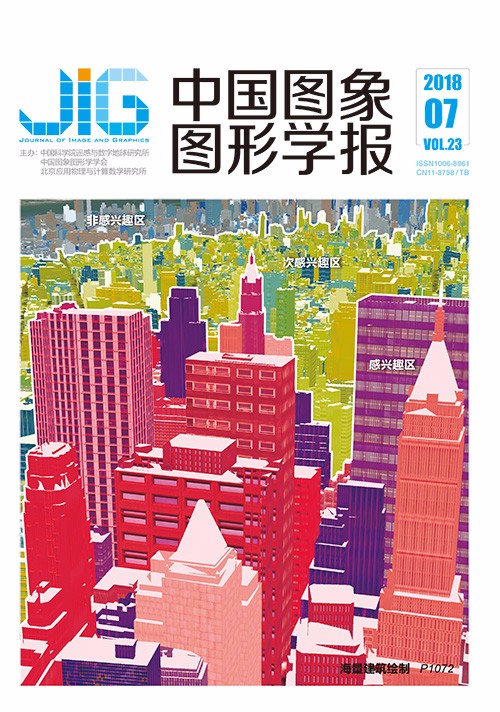
图形图像融合的海量建筑绘制
摘 要
目的 城市3维模型数据海量且结构复杂,缺乏一个高效完善的可视化系统往往是影响数字城市应用的瓶颈之一。通常利用多层次细节(LOD)与调度算法减少每一帧绘制的数据量来提高绘制效率,当场景规模足够大时,即使采用复杂的优化算法也难以取得较好的效果。为此,本文在传统算法基础上,提出一种图形图像融合的海量建筑物场景绘制方法。方法 提出并采用视域分级绘制策略,将视椎体平行分割为感兴趣区域、次感兴趣区域和非感兴趣区域,感兴趣区域采用图形实时绘制方法,使用离屏渲染技术将次感兴趣和非感兴趣区域绘制在纹理图像中,每一帧绘制完成后将二者进行顾及深度信息的融合,实现完整场景渲染。结果 使用公开的纽约市区CityGML文件作为实验数据,数据包含了118 195个LOD1和LOD2级别的建筑物模型。分别构建多组不同建筑数量的场景进行帧率统计实验,绘制帧率都达到20帧/s以上。算法实现了视觉无损失的场景完整渲染,并与Cesium平台进行对比实验,证明算法有效且系统运行流畅。结论 图形图像融合的绘制方法,既保持了图形渲染的漫游连续性,同时也具有图像渲染的场景复杂度无关的优点。实验结果表明,针对大规模的低分辨率建筑模型场景,算法可以有效提高系统的渲染能力,在性能相对较低的硬件条件下也能实现海量建筑物实体模型的流畅漫游,并达到视觉无损失的场景完整绘制。
关键词
Graphic-image mixed method for large-scale building rendering
Zhou Yang1, Hu Xiaofei1, Jin Caijiao2, Zhang Long1, Chen Andong1(1.Institude of Surveying and Mapping, Information Engineering University, Zhengzhou 450001, China;2.61175 Troops, Wuhan 430074, China) Abstract
Objective Constructing a smart city is an effective approach to achieve sustainable development and enhance the comprehensive competitiveness of cities. A 3D city visualization system is an important part of smart city applications. The structure of a 3D city building model is complex and the data are exceedingly huge. One of the bottlenecks that restrict the dissemination of digital 3D city applications is lack of an efficient and mature visualization system. Level of detail (LOD) and out-of-core algorithms are the key points in many existing large-scale building scene rendering techniques. The algorithms can improve the rendering efficiency by reducing the amount of data drawn in each frame. When the scene is sufficiently large, even the complex optimization algorithm cannot achieve improved results. Thus, rendering of 3D city buildings is extremely slow.Method A novel idea was developed based on the traditional study. We present a graphic-and image-mixed method for large-scale building scene rendering. First, the view frustum is split into three regions along the z axis, as follows:interesting region, less interesting region, and uninteresting region from near to far. We adopt the different rending methods in each region. The building models are drawn in the interesting region on the screen by the traditional graphics method. In the less interesting and uninteresting regions, the image-based rendering and off-screen rendering technology is used by applying the frame buffer object and render-to-texture technology and then drawing the building models on a texture image, where the render buffer is attached. At the end of each frame, the texture image is blended with the screen in consideration of the depth information to obtain the final rendering result. We design a 3D building tile model to improve the efficiency of data load and rendering. The city extent is split with grids. The buildings in the same grid cell compose a tile, and R-Tree index is used to search these tiles. The geo database 3Dcitydb is used in data processing.Result The algorithm is tested on a huge public CityGML model data in urban areas of New York, which includes 188195 building models at LOD0 and LOD1 levels. Several groups of experiments are conducted to compute the scene drawing frame rate. The amount of building model data varies in each experiment. The frame rate is better than 20 frame/s in each scene drawing experiment. We also compared the visualization result with Cesium platform. The LOD algorithm used in Cesium extracts only some distant buildings to improve the rendering efficiency. Some models are lost in the scene. However, this technology can draw the entire scene without any loss. The experimental result is acceptable and shows that the system is operating smoothly.Conclusion The graphic-image mixed scene rendering method maintained the continuity of scene roaming, and at the same time, has the advantage of image-based rendering technology, where the rendering frame rate is independent of the scene scale. The experimental results demonstrate that the algorithm can improve the data-bearing capacity of the visualization system, especially the large-scale low-resolution building scene. It can roam the huge building data smoothly under conditions of relatively low hardware performance and finally render the scene without vision loss.
Keywords
|



 中国图象图形学报 │ 京ICP备05080539号-4 │ 本系统由
中国图象图形学报 │ 京ICP备05080539号-4 │ 本系统由